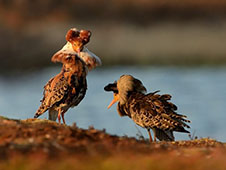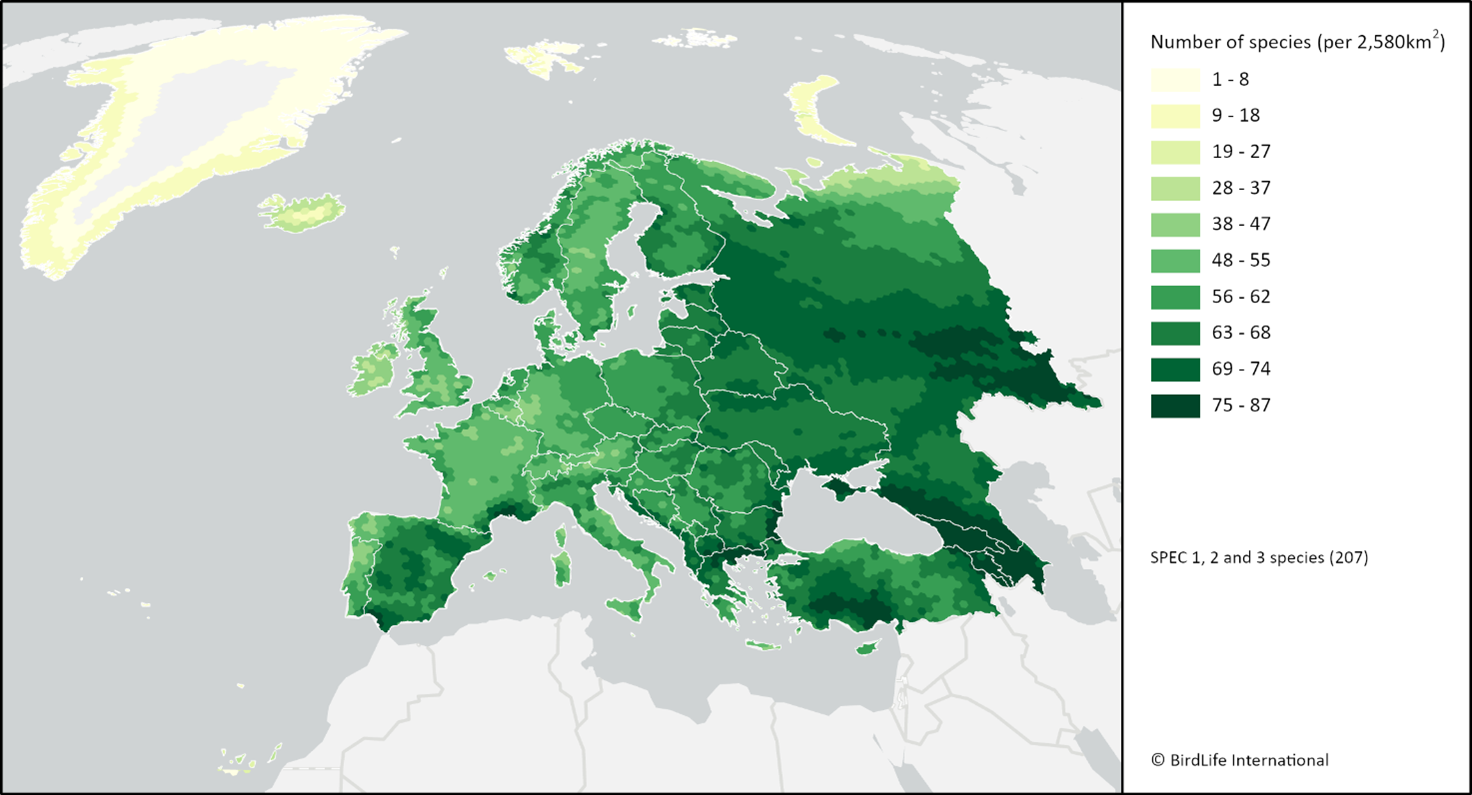
BirdLife’s fourth assessment of the population status of all of Europe’s 546 bird species reveals that 38% are of conservation concern, including 14% of global concern. Many species have been in trouble for decades and are still declining or depleted. Among them are numerous farmland and steppe birds, ducks, waders, raptors, seabirds and long-distance migrants. To this list, the latest assessment adds a range of species that breed in northern Europe and montane regions. Conservation action under policy instruments like the EU Birds Directive has helped some species to recover, including various raptors and large waterbirds. But much more action is needed to halt and reverse losses, highlighting the urgency of adopting and implementing comprehensive legislation for nature restoration.
Resources for nature conservation are limited, so regular reassessments of species’ population status, using the latest data to identify current priorities, are essential for ensuring that species in most need receive adequate attention promptly. If assessments are repeated consistently over time, they can also measure the effectiveness of conservation efforts and track progress towards conservation targets, like those in the European Union Biodiversity Strategy for 2030 and the Kunming-Montreal Global Biodiversity Framework.
BirdLife International has produced three previous assessments of the population status of all naturally occurring wild bird species in Europe, in 1994, 2004 and 2017. Each time, national population size estimates and trend data were collated for all native species, and assessed using quantitative criteria and thresholds to identify Species of European Conservation Concern (SPECs). The first assessment found that nearly 60% of SPECs were farmland birds, mainly due to population declines driven by agricultural intensification. The second assessment underlined this, but also highlighted population declines in many long-distance Afro-Palearctic migrants, raptors and steppe species. The third assessment further emphasised the plight of farmland birds and migrants, and also revealed population declines in many European seabirds.
Although SPECs have no formal legal status, their classification has strongly influenced bird conservation in Europe. By informing the identification of Important Bird and Biodiversity Areas (IBAs), hundreds of key sites for SPECs have been designated as protected areas within the Natura 2000 network under the EU Birds Directive and the Emerald Network under the pan-European Bern Convention. Many SPECs have been prioritised for the development of Species Action Plans, and some benefit from a higher EU co-funding rate for LIFE projects. Raptors classified as SPECs are also treated as priorities by the CMS Memorandum of Understanding on the Conservation of Migratory Birds of Prey in Africa and Eurasia (CMS Raptors MoU).
For the first and second assessments, data were collated through a network of national coordinators, via a collaboration between BirdLife International and the European Bird Census Council (EBCC). In 2011, EU Member States adopted a new system for reporting to the European Commission (EC) under Article 12 of the Birds Directive. Every six years, Member States must report on the implementation and impact of measures they have taken to conserve birds, including information on species’ population sizes and trends in their country. In the EU, therefore, the national data previously collated by BirdLife are now mobilised via an official intergovernmental process. For non-EU countries, with EC support, BirdLife has continued to collate national data through its Partners and EBCC contacts, combining the EU and non-EU datasets to undertake the third and fourth assessments. The latest data are available online (select a species from the table, and when the factsheet opens, click ‘Download’ and select ‘Supplementary Information’).
Of the 546 species assessed in 2023, 207 (38%) qualify as SPECs. The overall proportion of SPECs has remained similar across all four assessments, at 38–43%, but the number and proportion of species of global concern has trebled, from 24 (5%) in 1994 to 74 (14%) in 2023. This is alarming, and signifies that threats have increased and intensified, with iconic birds like Atlantic Puffin Fratercula arctica and European Turtle-dove Streptopelia turtur having become species of global conservation concern in recent years. SPECs are distributed throughout Europe, and every country has a responsibility for conserving them. Several regions hold particularly high numbers of species, including parts of Iberia, Turkey, the Caucasus and European Russia, as well as various coastal areas, indicating ‘hotspots’ for bird conservation (see fig. 1).
Figure 1: The distribution and number of Species of European Conservation Concern (SPECs) across Europe

Produced by overlaying BirdLife’s species range maps. Data from Burfield et al. (2023)
Overall, 44 species assessed as Non-SPECs in 2017 now qualify as SPECs, including many species that breed in Europe’s alpine, arctic and boreal regions, notably various waders, raptors and passerines. Conversely, 62 species listed as SPECs in 2017 are now assessed as Non-SPECs, including many whose earlier population declines have abated and which are now recovering, such as various herons and raptors. Regarding the EU Birds Directive, the number of specially protected (Annex I) species classified as SPECs has fallen by 33% since 1994, while the number of huntable (Annex II) species qualifying as SPECs has risen by 56% (see fig. 2).
Figure 2: The number of species on Annexes I and II of the EU Birds Directive classified as SPECs in each assessment.

Data from Burfield et al. (2023)
Despite some notable successes, efforts to halt biodiversity loss in Europe have clearly not been sufficient to stop the decline of many bird species. To achieve the 2030 biodiversity targets, the protection and management of key site networks for SPECs is vital, along with better implementation of targeted recovery actions, like those in the multi-species action plan for wet grassland breeding waders. To reverse the declines of many dispersed SPECs, particularly habitat specialists, this must be accompanied by extensive landscape-scale restoration efforts and by tackling more systemic drivers, such as by mainstreaming biodiversity into relevant sectoral policies, especially on agriculture, forestry, fisheries, energy and trade.
All these elements feature in the EC’s Nature Restoration Law, which should be adopted and approved in early 2024. Against this backdrop, this new assessment underlines the urgent need for adopting comprehensive restoration legislation, and provides clear priorities to help guide national restoration plans. Action must now be implemented at scale and pace, to halt and reverse the loss of Europe’s birds and meet regional and global restoration targets.
Related Species
References
Burfield, I.J., Rutherford, C.A., Fernando, E., Grice, H., Piggott, A., Martin, R.W., Balman, M., Evans, M.I. and Staneva, A. (2023) Birds in Europe 4: the fourth assessment of Species of European Conservation Concern. Bird Conserv. Int. 33: e66
Compiled: 2024 Last updated: 2024
Recommended citation:
BirdLife International (2024)
Birds in Europe 4: fourth assessment of species’ population status underlines urgent need for restoration.
Downloaded from https://datazone.birdlife.org/sowb/casestudy/birds-in-europe-4-fourth-assessment-of-species-population-status-underlines-urgent-need-for-restoration on 26/12/2024